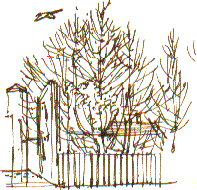 Train TimesFriday 24th March 2000, page 1/2 BEHIND the Skoda billboard by the station platform a Chiff-chaff sings on what used to be a siding amongst birches, sycamores and planted flowering cherries. This warbler has just made the journey from Africa. It's the first I've heard this spring. On one of the gantries there's a twiggy nest - Magpies?
BEHIND the Skoda billboard by the station platform a Chiff-chaff sings on what used to be a siding amongst birches, sycamores and planted flowering cherries. This warbler has just made the journey from Africa. It's the first I've heard this spring. On one of the gantries there's a twiggy nest - Magpies?
Coal Measures (Carboniferous); 300 m.y.a.
Magnesian Limestone (Permian); 250 m.y.a. Soon after South Elmsall we're cutting into the creamy coloured cuttings of the Magnesain Limestone, laid down in a dying sea, now known as the Zechstein Sea, 250 million years ago, at the time of the ancestral dinosaurs.
Soon after South Elmsall we're cutting into the creamy coloured cuttings of the Magnesain Limestone, laid down in a dying sea, now known as the Zechstein Sea, 250 million years ago, at the time of the ancestral dinosaurs.
Desert Sandstone (Triassic); 230 m.y.a. There's just a glimpse of the soft red sandstones of the Triassic desert at Doncaster station. A reminder of the time when Britain was landlocked at the arid heart of Pangaea, the biggest landmass that has ever existed.
There's just a glimpse of the soft red sandstones of the Triassic desert at Doncaster station. A reminder of the time when Britain was landlocked at the arid heart of Pangaea, the biggest landmass that has ever existed.  Just south of the city, a flooded gravel pit is now managed as the Yorkshire Wildlife Trust Potteric Carr nature reserve. Just south of the city, a flooded gravel pit is now managed as the Yorkshire Wildlife Trust Potteric Carr nature reserve. There's a very English stretch of meandering river by the small town of Bawtry. The hills start rolling again after Retford and we're back to river valley gravel pits, on a much larger scale, when we cross the River Trent at Newark.
There's a very English stretch of meandering river by the small town of Bawtry. The hills start rolling again after Retford and we're back to river valley gravel pits, on a much larger scale, when we cross the River Trent at Newark.
Jurassic Scarp; 200 m.y.a.  We cross a plain on which, for miles, the highest points are the tops of the trees and then it's time to stop at Grantham at the foot of the Jurassic scarp. We've travelled south 65 miles south-east and through a hundred million years of time, from the days of the coal forests, 300 million years ago, to the dinosaurs and giant marine reptiles of the Jurassic.
We cross a plain on which, for miles, the highest points are the tops of the trees and then it's time to stop at Grantham at the foot of the Jurassic scarp. We've travelled south 65 miles south-east and through a hundred million years of time, from the days of the coal forests, 300 million years ago, to the dinosaurs and giant marine reptiles of the Jurassic.
Concealed Coalfield (Carboniferous/Triassic); 300/230 m.y.a.
|
 Soon we're going through a cutting in coal measures sandstones. The sand was laid down in river deltas at the same time that swampy tropical forests here were building up the layers of peat that would become layers of coal.
Soon we're going through a cutting in coal measures sandstones. The sand was laid down in river deltas at the same time that swampy tropical forests here were building up the layers of peat that would become layers of coal.  At the foot of a landscaped pit-heap near South Elmsall there's what appears to be a present-attempt to produce bio-mass; there's a densely planted rectangle of willow saplings.
At the foot of a landscaped pit-heap near South Elmsall there's what appears to be a present-attempt to produce bio-mass; there's a densely planted rectangle of willow saplings. At Keyworth I get a chance to examine a borehole core from the Vale of Belvoir coalfield which cuts into the vent one of the volcanoes that was active at that time. These Vale of Belvoir volcanoes are of course completely hidden by the later desert deposits, but volcanic vents of about the same period can be seen in Edinburgh, at the Arthur's Seat volcanic vent and sill, and the Edinburgh Castle rock.
At Keyworth I get a chance to examine a borehole core from the Vale of Belvoir coalfield which cuts into the vent one of the volcanoes that was active at that time. These Vale of Belvoir volcanoes are of course completely hidden by the later desert deposits, but volcanic vents of about the same period can be seen in Edinburgh, at the Arthur's Seat volcanic vent and sill, and the Edinburgh Castle rock.